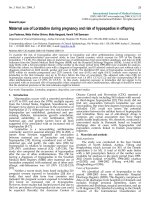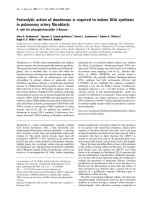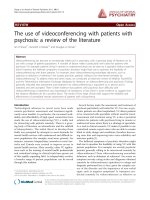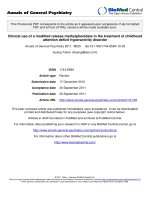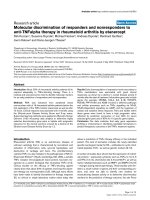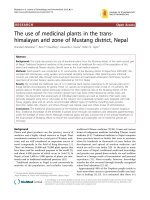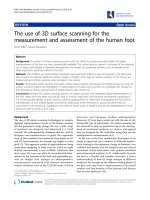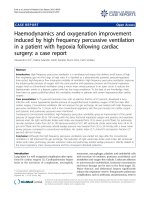Báo cáo y học: " Successful use of inhaled nitric oxide to decrease intracranial pressure in a patient with severe traumatic brain injury complicated by acute respiratory distress syndrome: a role for an anti-inflammatory mechanism?" doc
Bạn đang xem bản rút gọn của tài liệu. Xem và tải ngay bản đầy đủ của tài liệu tại đây (598.86 KB, 6 trang )
BioMed Central
Page 1 of 6
(page number not for citation purposes)
Scandinavian Journal of Trauma,
Resuscitation and Emergency Medicine
Open Access
Case report
Successful use of inhaled nitric oxide to decrease intracranial
pressure in a patient with severe traumatic brain injury complicated
by acute respiratory distress syndrome: a role for an
anti-inflammatory mechanism?
Thomas J Papadimos*
1,2
, Azedine Medhkour
3
and Sooraj Yermal
1
Address:
1
Department of Anesthesiology, College of Medicine, University of Toledo, 3000 Arlington Avenue, Toledo, OH 43614, USA,
2
Department of Anesthesiology, School of Medicine, University of Michigan, 1500 E. Medical Center Drive, Ann Arbor, MI 48109, USA and
3
Deparment of Surgery, Division of Neurosurgery, College of Medicine, University of Toledo, 3000 Arlington Avenue, Toledo, OH 43614, USA
Email: Thomas J Papadimos* - ; Azedine Medhkour - ;
Sooraj Yermal -
* Corresponding author
Abstract
Use of inhaled nitric oxide in humans with traumatic brain injury and acute respiratory distress
syndrome has twice previously been reported to be beneficial. Here we report a third case. We
propose that INO may decrease the inflammatory response in patients with increased intracranial
pressure caused by traumatic brain injury accompanied by acute respiratory distress syndrome
thereby contributing to improved outcomes.
Background
Traumatic brain injury (TBI) affects 1.4 million Americans
each year, which includes 1.1 million emergency depart-
ment visits, 235,000 hospitalizations, and 50,000 deaths
[1]. Approximately 5.3 million Americans are disabled
with TBI [2] at a cost of $60 billion annually [3].
In the face of severe pulmonary insufficiency, such as
occurs in neurogenic pulmonary edema, pneumonia, and
acute lung injury (ALI)/acute respiratory distress syn-
drome (ARDS) oxygen delivery to the brain may be com-
promised. To avert an increase in intracranial pressure
(ICP) caused by severe TBI, i.e., Glasgow Coma Scale
(GCS ≤ 8), it has been recommended that the partial pres-
sure of oxygen in arterial blood (PaO2) be maintained at
a minimum of 100 mm Hg [4], cerebral perfusion pres-
sure be maintained between 60–70 mm Hg [5], and the
partial pressure of carbon dioxide in arterial blood
(PaCO2) be maintained at 32–35 mm Hg [6].
The release of cytokines [7] and neuropeptides [8] that
injure the brain occurs in patients subjected to TBI. This
inflammatory response causes the pulmonary system to
be less tolerant to the stressors of ischemia-reperfusion
and subsequent mechanical insults [9]. Massive brain
injury may precipitate ventilator induced lung injury,
thereby worsening the outcome. This may occur through
neurogenic pulmonary edema [10], ventilator associated
pneumonia [11], and/or ALI/ARDS [12] that may result
from inflammatory activation of pneumatocyte type II
cells [13]. This may occur through the initiation and
migration of activated neutrophils into the lungs [14]. In
our institution there have been 264 patients with a GCS ≤
8 over the past 36 months, 216 (81.8%) needed ventilator
Published: 17 February 2009
Scandinavian Journal of Trauma, Resuscitation and Emergency Medicine 2009, 17:5 doi:10.1186/1757-7241-17-5
Received: 26 November 2008
Accepted: 17 February 2009
This article is available from: />© 2009 Papadimos et al; licensee BioMed Central Ltd.
This is an Open Access article distributed under the terms of the Creative Commons Attribution License ( />),
which permits unrestricted use, distribution, and reproduction in any medium, provided the original work is properly cited.
Scandinavian Journal of Trauma, Resuscitation and Emergency Medicine 2009, 17:5 />Page 2 of 6
(page number not for citation purposes)
support (tracheal intubation), 64 (29.6%) acquired
ARDS, and of these, 22/64 (34.3%) died.
Over the past 9 years inhaled nitric oxide (INO) has been
used twice in a severely head injured human with ALI/
ARDS with success [15,16]. INO, delivered at 10–80 parts
per million (ppm), is a very effective pulmonary vasodila-
tor [17] and improves arterial oxygenation [18-22]. How-
ever, INO use may not only improve arterial oxygenation,
but it may also provide potent anti-inflammatory effects
[23]. Here we report a case of severe traumatic brain injury
with dramatically elevated intracranial pressure in the set-
ting of ARDS that successfully responded to use of INO
that was used as an adjunct to traditional therapy.
Case presentation
A 37 year old male involved in a motor cycle accident
(unhelmeted) was found unresponsive at the scene. His
trachea was intubated at the scene, resuscitated with flu-
ids, and transported to the University of Toledo Medical
Center via air ambulance. The patient arrived with a blood
pressure 186/96 mm Hg, heart rate 79 beats per minute,
SpO2 90% on 1.0 FiO2, and his Glasgow coma scale was
3. His pupils were round and equally reactive to light at 3
mm bilaterally. A right 9 French femoral venous sheath
and a left femoral arterial catheter were placed on arrival.
Complete blood count revealed hemoglobin 14.4 g/dl,
hematocrit 41.8%, platelets 218,000/mm
3
, white blood
cell count 19,800/mm
3
, sodium 143 meq/L, potassium
3.5 meq/L, chloride 109 meq/L, Carbon dioxide 26 mm
Hg, blood urea nitrogen 12 mg/dl, creatinine 1.2 mg/dl,
glucose 139 mg/dl, calcium 8.2 mg/dl, prothrombin time
15.8 seconds, international normalized ratio 1.2, albumin
3.4 g/dl, total bilirubin 0.9 mg/dl, alkaline phosphatase
64 IU/L, aspartate aminotransferase 57 IU/L, and alanine
aminotransferase 43 IU/L. The initial arterial blood gas
was pH 7.35, PaCO2 26 mm Hg, PaO2 60 mm Hg, HCO3
20 mmol/L, and base excess -5 mmol/L. The patient was
given 10 mg vecuronium, and 25 grams of mannitol
twice, intravenously. An electrocardiogram revealed a nor-
mal sinus rhythm, and the chest roentgenogram revealed
bilateral pulmonary edema, a small left apical pneumoth-
orax, multiple fractured ribs on the right, and a severely
congested right lung field. His SpO2 suddenly decreased
to 78% with diminished breath sounds bilaterally, and
bilateral chest tubes were placed with improvement of the
SpO2 to 90%. Subsequent computed tomography (CT)
scan of the chest confirmed a left pneumothorax, that the
right chest was filled with fluid (there was a question of
aspiration), and the presence of bilateral pulmonary
edema; CT of head demonstrated a left occipital fracture,
multiple intraparenchymal hemorrhages, and a left sub-
dural hematoma that was determined not to need surgical
evacuation because of its size and minimal midline shift
(see CT scan figures 1, 2, 3); and the CT scan of the abdo-
men was negative.
He was transferred to the intensive care unit where a right
internal jugular 9 French sheath was placed for introduc-
tion of a pulmonary artery catheter, as was an intracranial
pressure monitor (Camino). His initial ICP and cerebral
perfusion pressure were 37 mm Hg and 57 mm Hg,
respectively, on ventilator settings of assist control (AC)
30 (respiratory rate was 34), positive end expiratory pres-
sure (PEEP) of 0 (zero) mm Hg, tidal volume (Vt) 650 ml,
FiO2 1.0, with an ABG of pH 7.28, PaCO2 44 mm Hg,
PaO2 63 mm Hg, and HCO3 20 meq/L. The SpO2 was
92%, the central venous pressure was 12 mm Hg, and the
lactate was 8.5 mmol/L (which improved with further
resuscitation).
Over the next seven days the patient's pulmonary status
deteriorated and severe ARDS became manifest in the face
of continued high ICP despite intensive intervention. On
the morning of the seventh hospital day a critical point
was reached. The ICP spiked to 70 mm Hg and remained
over 50 mm Hg for greater than 2 minutes notwithstand-
ing the use of mannitol, furosemide, hyperventilation,
sedation, and paralysis, although these efforts maintained
the CPP from 47–77 mm Hg. This high ICP occurred in
the face of hypoxia and acidemia; ABG of pH 7.33, PaCO2
50 mm Hg, PaO2 54 mm Hg, base excess 0.1 mmol/L, and
HCO3 26 meq/L while ventilated on AC 50 with Vt 500
ml, PEEP 7 cm H2O, and FiO2 1.0. The cardiac output was
11 liters/minute, and the cardiac index was 4.9 liters/
minute/m
2
. The PEEP was raised to 17 cm H2O incremen-
tally, while at the same time carefully evaluating ICP, peak
inspiratory and plateau pressures, and oxygenation, in an
effort to increase the PaO2 to an acceptable level (a goal
of PaO2 100 mm Hg). In view of the fact that maximized
ventilator settings, adequate sedation, paralysis, and inha-
lational therapies (albuterol and ipratropium) had nei-
ther improved the patient's intracranial pressures, nor his
oxygenation, use of INO was implemented specifically to
improve oxygenation and thereby decrease ICP. INO was
instituted at 20 ppm. In a period of 35 minutes the ICP
decreased to 15 mm Hg and PaO2 improved; ABG pH
7.35, PaCO2 49 mm Hg, PaO2 86 mm Hg, BE 0.7, and
HCO3 27 meq/L on the same ventilator settings. Over 6
hours the PEEP was weaned to 11 cm H2O and the PaO2
remained at 90 mm Hg with the ICP ranging from 15–29
mm Hg. After 24 hours of INO at 20 ppm the ICP ranged
from 12–20 mm Hg and the ABG was pH 7.47, PCO2 43
mm Hg, PaO2 165 mm Hg, BE 7.1 and HCO3 31 meq/L
on AC 45, Vt 550, FiO2 95% and PEEP of 8 mm Hg. The
INO was weaned over several days (there was no evidence
of methemoglobinemia). The patient was discontinued
from mechanical ventilation on hospital day 30. CT scan
demonstrated no mass effect, but atrophy and hypoden-
Scandinavian Journal of Trauma, Resuscitation and Emergency Medicine 2009, 17:5 />Page 3 of 6
(page number not for citation purposes)
sity of the left temporal lobe. He was discharged to a reha-
bilitative traumatic brain injury unit on hospital day 34.
Although he could follow commands, he had post-trau-
matic amnesia, a right hemiparesis, and moderate-severe
cognitive, linguistic and language defects.
Discussion
The patient's critically elevated ICP did not respond to tra-
ditional, aggressive neurointensive care modalities alone,
but the addition of INO to these interventions was associ-
ated with a significant decrease in ICP that was life-saving.
This patient's decrease in ICP could have occurred for sev-
eral reasons. First, the occurrence of pulmonary vasodila-
tion could have created a "sink" effect in which such
vasodilation simply allowed more of the blood volume to
remain in the thorax or to drain from the cerebral circula-
tion to the thorax. Also, pulmonary vasodilation and
increased PEEP (with an FiO2 of 1.0) could have provided
improved oxygenation to the brain thus decreasing the
ICP. In infants, however, there is evidence of increased
cerebral blood flow with INO [24], thus potentially
increasing ICP. Finally, while INO is a potent pulmonary
vasodilator, and has been thought to remain only in the
pulmonary system because it degrades quickly in vivo
[17], it may act downstream (NO delivery beyond the
lungs) to improve other organs through anti-inflamma-
tory mechanisms [23]. The intriguing alternative of an
anti-inflammatory extra-pulmonary delivery deserves fur-
ther exploration.
The red blood cell (RBC) is now hypothesized to be the
deliverer of nitric oxide (NO), not the consumer of NO
[25]. NO reacts with heme iron and with cysteine (Cys)-
93 on the hemoglobin β-sub unit [26]. NO reactions with
heme iron will cause NO's inactivation, but S-nitrosyla-
tion of Cys-93 makes hemoglobin a carrier of NO bioac-
tivity [27]. Also, an increase in S-nitrosothiol proteins
occurs in sepsis (including RBC S-nitrosothio-hemo-
globin and hemoglobin [Fe]NO) [28,29]. This accumula-
tion of hemoglobin [Fe]NO as a 5-coordinate α-heme NO
does not allow NO release to the Cys-β93 residue. Deliv-
ery of oxygen occurs without extensive vasodilation
because of the dissociation of oxygen from the 5-coordi-
nate α-heme-NO [30]. Thus, according to Goldfarb and
Cinel, NO excess that interacts with hemoglobin will lead
to products that prevent NO toxicity [31]. They also point
out that S-nitrosylated albumin can transport NO bioac-
tivity downstream to other organs [31] and that NO stabi-
lized through hemoglobin, or other proteins through
reversible S-nitrosylation, may be the manner in which
NO extrapulmonary effects get downstream [31].
INO and glucocorticoid regulation is also of importance
in sepsis and in TBI. Da et al demonstrated that glucocor-
ticoid receptor (GR) up-regulation decreased the inflam-
matory response in a porcine model of sepsis using INO
in combination with glucocorticoids (neither interven-
tion worked well alone) [24]. However, contrary to Da et
al, some animal models demonstrate that up-regulation
of GR is neurotoxic [32-35]. After a cortical injury in these
models, the rat hippocampus underwent cell loss because
of an acute elevation of glucocorticoids. This model of GR
up-regulation was considered detrimental [32]. A GR
blocking agent, RU486 (mefepristone), though, was
shown to be useful in this type of injury [34]. Therefore,
there may be neuroprotection afforded to those with TBI
due to down-regualtion by GR causing a low adrenocorti-
cotropin (ACTH) level. This has been borne out in ani-
mals that underwent fluid percussion injury; their
hypothalamic mRNA expression was increased [36]. High
levels of total serum cortisol, ACTH, and catecholamines
are present early in TBI [37,38], but a low plasma ACTH
concentration in early TBI is associated with a better
chance of intensive care unit (ICU) survival [39,40].
It may be that patients with TBI have adaptive down-reg-
ulation as demonstrated by Lee et al in an animal model
in which cortical GR expression was down-regulated after
6 hours of injury in the ischemic cortex, and after 24 hours
in the non-ischemic cortex in rats [41], indicating an
attempt at neuroprotection. In humans such down-regu-
lation has been demonstrated, but it may take a longer
Computed tomography scan at the level of the midbrainFigure 1
Computed tomography scan at the level of the mid-
brain. Multiple contusions involving the left temporal lobe
are evident (arrows). A = anterior; P = posterior; L = left; R
= right.
Scandinavian Journal of Trauma, Resuscitation and Emergency Medicine 2009, 17:5 />Page 4 of 6
(page number not for citation purposes)
time [39]. Past studies have confirmed that the hippocam-
pus is, indeed, involved in hypothalamic-pituitary-adre-
nal axis inhibition [42-44]. Stimulation of the
hippocampus lowers glucocorticoid release in rats and
humans [45,46], whereas hippocampal lesions increase
corticosterone and corticotropin release in rats [47-50].
This probably occurs secondary to a damaged hippocam-
pus, which will increase paraventricular corticotropin
releasing hormone and arginine vasopressin gene expres-
sion resulting in an increase of ACTH [51-53].
INO reaching the central nervous system may allow GR in
the brain to be downregulated. Aaltoren et al have shown
that pigs with meconium aspiration have hippocampal
neuronal injury [54]. However, when INO is administered
to pigs with meconium aspiration, neuronal injury to the
hippocampus is inhibited [55]. This occurs through
diminished oxidation of DNA in the hippocampus and is
accompanied by decreased levels of glutathione (a
biomarker of oxidative stress) [55].
It is possible that INO moving downstream may be deliv-
ered to the brain and cause GR expression in the brain/
hippocampus to be muted. This would produce a neuro-
protective effect while at the same time allowing the rest
of the body to up-regulate GR in response to steroids and
INO administration thereby assisting the body in its
efforts at combating inflammation.
The use of INO in this report was for emergent and com-
passionate use in the setting of critically elevated intracra-
nial pressure accompanied by ARDS, hypoxemia, and
high PEEP. The patient's spouse was fully informed of the
reasons for the use of INO and the potential conse-
quences. The institutional ethics committee was not con-
sulted for use of INO in this situation because of the
compressed time-line for decision-making and interven-
tion. However, after the event members of the ethics com-
mittee and the institutional review board were consulted
regarding the continued use of INO in this case and simi-
lar situations in the future.
Conclusion
INO in humans with TBI and ARDS has now been used
successfully on three occasions to improve outcomes.
Although it has also been shown to be effective in hippoc-
ampal preservation and in decreasing inflammation in
animals, any hypothesis regarding humans arising from
our observations should be tested in rigorously designed
experimental and clinical studies.
Consent
The corresponding author received consent from the
patient's wife (next of kin) for publication of this report.
Computed tomography scan at the level of the lateral ventri-clesFigure 3
Computed tomography scan at the level of the lat-
eral ventricles. There is a thin layer of acute subdural
hematoma identified on the left with a minimal midline shift
(arrow). A = anterior; P = posterior; L = left; R = right.
Computed tomography scan at the level of the orbitsFigure 2
Computed tomography scan at the level of the
orbits. Punctiform contusions involving the left temporal
and frontal lobes with effacement of the left occipital horn
are demonstrated (arrows). A = anterior; P = posterior; L =
left; R = right.
Scandinavian Journal of Trauma, Resuscitation and Emergency Medicine 2009, 17:5 />Page 5 of 6
(page number not for citation purposes)
Competing interests
The authors declare that they have no competing interests.
Authors' contributions
TJP cared for the patient and participated in all portions of
the paper, AM cared for the patient and participated in the
case report section, SY participated in the case report sec-
tion.
References
1. Murray CJ, Lopes AD: Global Health Statistics Geneva: World Health
Organization; 1996.
2. Thurman D, Alverson C, Dunn K, Guerrero J, Sniezek J: Traumatic
brain injury in the United States: a public health perspective.
J Head Trauma Rehabil 1999, 14:602-615.
3. Finkelsein E, Corso P, Miller T: The incidence and economic burden of
injuries in the United States New York: Oxford University Press; 2006.
4. Cohen SM, Marion DW: Traumatic Brain Injury. In Textbook of
Critical Care Edited by: Fink MP, Abraham E, Vincent J-L, Kochanek PM.
Philadelphia: Elsevier; 2005:377-385.
5. Rosner MJ, Rosner SD: Cerebral perfusion in head injury. In
Intracranial Pressure VIII Edited by: Avezaat CJJ, van Eijndhoven JHM,
Maas AIR. Berlin: Springer-Verlag; 1993:540-545.
6. Stocchetti N, Maas AIR, Chieregato A, Plas AA van der: Hyperven-
tilation in head injury: a review. Chest 2005, 127:1812-1827.
7. Moranti-Kossman MC, Rancan M, Stahel PF, Kossman T: Inflamma-
tory response in acute brain injury: a double-edged sword.
Curr Opin Crit Care 2002, 8:101-105.
8. Rall JM, Matslievich DA, Dash PK: Comparative analysis of
mRNA levels in the frontal cortex and the hippocampus in
the basal state and in response to experimental brain injury.
Neuropathol Appl Neurobiol 2003, 29:18-131.
9. Lopes-Aguilar J, Villagra Ana, Bernabe F, Murias G, Piacentini E, Real
J, Fernandez-Segoviano P, Romero PV, Hotchkiss JR, Blanch L: Mas-
sive brain injury enhances lung damage in an isolated lung
model of ventilator-induced injury. Crit Care Med 2005,
33:1077-1083.
10. Zygun DA, Kortbeek JB, Fick GH, Laupland KB, Doig CJ: Non-neu-
rologic organ dysfunction in severe traumatic brain injury.
Crit Care Med 2005, 33:654-660.
11. Zygun DA, Zuege DJ, Boiteau PJ, Laupland KB, Henderson EA, Kort-
beek , Doig CJ: Ventilator-associated pneumonia in severe
traumatic brain injury. Neurocrit Care 2006, 5:108-114.
12. Holland MC, Mackersie RC, Morabito D, Campbell AR, Kivett VA,
Patel R, Erickson VR, Pittet JF: The development of acute lung
injury is associated with worse neurologic outcome in
patients with severe traumatic brain injury. J Trauma 2003,
55:106-111.
13. Yildirim E, Kaptanoglu E, Ozisik K, Beskonakli E, Okutan O, Sargon
MF, Kilinc K, Sakinci U: Ultrastructural changes in pneumato-
cyte type II cells following traumatic brain injury in rats. Eur
J Cardiothorac Surg 2004, 25:523-529.
14. Strieter RM, Kunkel SL: Acute Lung Injury: the role of cytokines
in the elicitation of neutrophils. J Investig Med 1994, 42:640-651.
15. Peillon D, Jault V, Le Vavaseur O, Bellanger-Depagne JJ, Combe C:
Effet du monoxyde d'azote inhale chez une patiente atteinte
d'hypertension intracranienne. Ann Fr Anesth Reanim 1999,
18:225-229.
16. Vavilala MS, Roberts JS, Moore AE, Newell DW, Lam AM: The influ-
ence of inhaled nitric oxide on cerebral blood flow and
metabolism in a child with traumatic brain injury. Anesth Analg
2001, 93:351-353.
17. Griffiths MJD, Evans TW: Inhaled nitric oxide therapy in adult.
N Eng J Med 2005, 353:2683-2695.
18. Herridge MS, Cheung AM, Tansy CM, Matte-Martyn A, Diaz-Grana-
dos N, Al-Saidi F, Cooper AB, Guest CB, Mazer CD, Mehta S, Stewart
TF, Barr A, Cook D, Slutsdky AS: One year outcomes in survi-
vors of the acute respiratory syndrome. N Eng J Med 2003,
348:683-693.
19. Rubenfeld GD, Caldwell E, Peabody E, Weaver J, Martin DP, Neff M,
Stern EJ, Hudson LD: Incidence and outcomes of acute lung
injury. N Eng J Med 2005, 353:1685-1693.
20. Herridge MS, Angus DC: Acute Lung Injury – affecting many
lives. N Eng J Med 2005, 353:1736-1738.
21. Linde-Zwirble WT, Clermont G, Coleman MB, Brodak S, Angus DC:
Incidence of ARDS in the US, Europe, and Japan. In Proceed-
ings of the 9th European Congress in Intensive Care Medicine Edited by:
Bennet D. Bologna, Italy: Moduzzi Editore; 1996:243-246.
22. Abman SH, Greibel JL, Parker DK, Schmidt JM, Swanton D, Kinsella
JP: Acute effects of inhaled nitric oxide in children with
severe hypoxemic respiratory failure. J Pediatr 1994,
124:881-888.
23. Da J, Chen L, Hedenstierna G: Nitric oxide up-regulates the glu-
cocorticoid receptor and blunts the inflammatory reaction
in porcine endotoxin sepsis. Crit Care Med 2006, 35:26-32.
24. Day RW:
Cerebral blood flow velocity acutely decreases in
newborns who respond to inhaled nitric oxide. Am J Perinatol
2001, 13:185-194.
25. Gow AJ: The biological chemistry of nitric oxide as it pertains
to the extrapulmonary effects of inhaled nitric oxide. Proc Am
Thorac Soc 2006, 3:150-152.
26. Luchsinger BP, Rich EN, Gow AJ, Andrew J, Williams EM, Stamler JS,
Singel DJ: Routes to S-nitroso-hemoglobin formation with
heme redox and preferential reactivity in the B subunits. Proc
Nat Acad Sci USA 2003, 100:461-466.
27. Robinson JM, Lancaster JR: Hemoglobin-mediated, hypoxia-
induced vasodilation via nitric oxide: mechanism(s) and
physiologic versus pathological relevance. Am J Respir Cell Mol
Biol 2005, 32:257-261.
28. Kosaka H, Watanabe M, Yoshihara H, Harada N, Shiga T: Detection
of nitric oxide production in lipopolysaccharide-treated rats
by ESR using carbon monoxide hemoglobin. Biochem Biophys
Res Commun 1992, 184:1119-1124.
29. Jourd'heuil D, Gray L, Grisham MB: S-nitrosothiol formation in
blood of lipopolysaccharide-treated rats. Biochem Biophys Res
Commun 2000, 273:22-26.
30. Doctor A, Platt R, Sheram ML, Eischeid A, McMahon T, Maxey T,
Doherty J, Axelrod M, Kline J, Gurka M, Gow A, Gaston B: Hemo-
globin conformation couples erythrocyte S-nitrosothio con-
tent to O2 gradients. Proc Nat Acad Sci USA 2005, 102:5709-5714.
31. Goldfarb RD, Cinel I: Inhaled nitric oxide therapy for sepsis:
more that just lung. Crit Care Med 2007, 35:290-291.
32. McCullers DL, Herman JP: Adrenocorticosteroid receptor
blockade and excitotoxic challenge regulated adrenocorti-
costeroid receptor mRNA levels in the hippocampus. J Neu-
rosci Res 2001, 64:277-283.
33. McCullers DL, Sullivan PG, Scheff SW, Herman JP: Traumatic brain
injury regulates adrenocorticosteroid receptor mRNA levels
in rat hippocampus. Brain Res 2002, 947:41-49.
34. McCullers DL, Sullivan PG, Scheff SW, Herman JP: Mifepristone
protects CA1 hippocampal neurons following traumatic
brain injury in rat. Neuroscience 2002, 109:219-230.
35. Herman JP, Seroogy K: Hypothalanic-pituitary-adrenal axis, glu-
cocorticoids, and neurologic disease. Neurol Clin 2006,
24:461-481.
36. Grundy J, Harbuz MS, Jessop DS, Lightman SL, Sharples PM: The
hypothalamo-pituitary-adrenal axis response to experimen-
tal traumatic brain injury. J Neurotrauma 2001, 18:1373-1381.
37. Bondanelli M, Ambrosio M, Zatelli MC, De Marinis L, delgli Uberti EC:
Hypopituitarism after traumatic brain injury. Eur J Endocrinol
2005, 152:679-691.
38. Berge G Van den: Novel insights into the neuroendocrinology
of critical illness. Eur J Endocrinol 2000, 143:1-13.
39. Llompart-Pou JA, Raurich JM, Ibanez J, Burguera B, Barcelo A, Ayes-
taran JI, Perez-Barcena I: Relationship between plasma adreno-
corticotropin hormone and intensive care unit survival in
early traumatic brain injury. J Trauma 2007, 62:1457-1461.
40. Koiv L, Merisalu E, Zilmer K, Tomberg T, Kaasik AE: Changes of
sympatho-adrenal and hypothalamo-pituitary-adrenocorti-
cal system in patients with head injury. Acta Neurol Scand 1997,
96:52-58.
41. Lee BH, Wen TC, Rogido M, Sola A: Glucocorticoid receptor
expression in the cortex of the neonatal rat brain with and
without focal ischemia. Neonatology 2007, 91:12-19.
42. Herman JP, Cullinan WE: Neurocircuitry of stress: central con-
trol of the hypothalamo-pituitary-adrenal axis. Trends Neurosci
1997, 20:78-84.
Publish with BioMed Central and every
scientist can read your work free of charge
"BioMed Central will be the most significant development for
disseminating the results of biomedical research in our lifetime."
Sir Paul Nurse, Cancer Research UK
Your research papers will be:
available free of charge to the entire biomedical community
peer reviewed and published immediately upon acceptance
cited in PubMed and archived on PubMed Central
yours — you keep the copyright
Submit your manuscript here:
/>BioMedcentral
Scandinavian Journal of Trauma, Resuscitation and Emergency Medicine 2009, 17:5 />Page 6 of 6
(page number not for citation purposes)
43. Jacobson L, Sapolsky RM: The role of the hippocampus in feed-
back regulation of the hypothalamic-pituitary-adrenocorti-
cal axis. Endocr Rev 1991, 12:118-134.
44. Sapolsky RM, Krey LC, McEwan BS: The neuroendocrinology of
stress and aging: the glucocorticoid cascade hypothesis.
Endocr Rev 1986, 7:284-301.
45. Dunn JD, Orr SE: Differential plasma corticosterone responses
to hippocampal stimulation. Exp Brain Res 1984, 54:1-6.
46. Rubin RT, Mandell AJ, Crandall PH: Corticosteroid responses to
limbic stimulation in man: localization of stimulation sites.
Science 1966, 153:767-768.
47. Fendler K, Karmos G, Telegdy G: The effect of hippocampal
lesion on pituitary-adrenal function. Acta Physiol Acad Sci Hung
1961, 20:293-297.
48. Knigge KM: Adrenocortical respose to stress in rats with
lesions in hippocampus and amygdala. Proc Soc Exp Biol Med
1961, 108:18-21.
49. Knigge KM, Hays M: Evidence of inhibitive role of hippocampus
in neural regulation of ACTH release. Proc Soc Exp Biol Med
1963, 114:67-69.
50. Sapolsky RM, Krey LC, McEwan BS: Glucocorticoid-sensitive hip-
pocampal neurons are involved in terminating the adreno-
cortical response. Proc Natl Acad Sci USA 1984, 81:6174-6177.
51. Herman JP, Cullinan WE, Morano MI, Akil H, Watson SJ: Contribu-
tion of the ventral subiculum to inhibitory regulation of the
hypothalamic-pituitary-adrenocortical axis. J Neuroendocrinol-
ogy 1995, 7:475-482.
52. Herman JP, Cullinan WE, Young EA, Akil H, Watson SJ: Selective
forebrain fiber tract lesions implicate ventral hippocampal
structures in tonic regulation of paraventricular nucleus
CRH and AVP mRNA expression. Brain Res 1992, 592:228-238.
53. Herman JP, Schafer MK, Young EA, Thompson R, Douglass J, Akil H,
Watson SJ: Evidence for hippocampal regulation of neuroen-
docrine neurons of the hypothalamic-pituitary-adrenocorti-
cal axis. J Neurosci 1989, 9:3072-3082.
54. Aaltonen M, Soukka H, Halkila L, Kalimo H, Holopainen IE, Kaapa PO:
Meconium aspiration induces neuronal injury in piglets. Acta
Paediatr 2005, 94:1468-1475.
55. Aaltonen M, Soukka H, Halkola L, Jalonen J, Kalimo H, Holopainen IE,
Kaapa P: Inhaled nitric oxide treatment inhibits neuronal
injury after meconium aspiration in piglets. Early Hum Dev
2007, 83:77-85.
